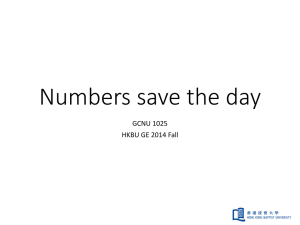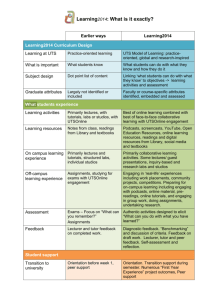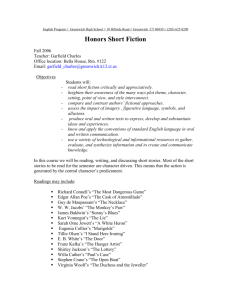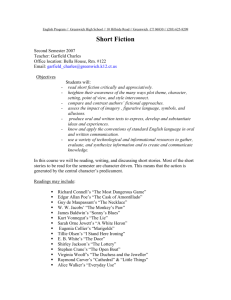Course Information
advertisement
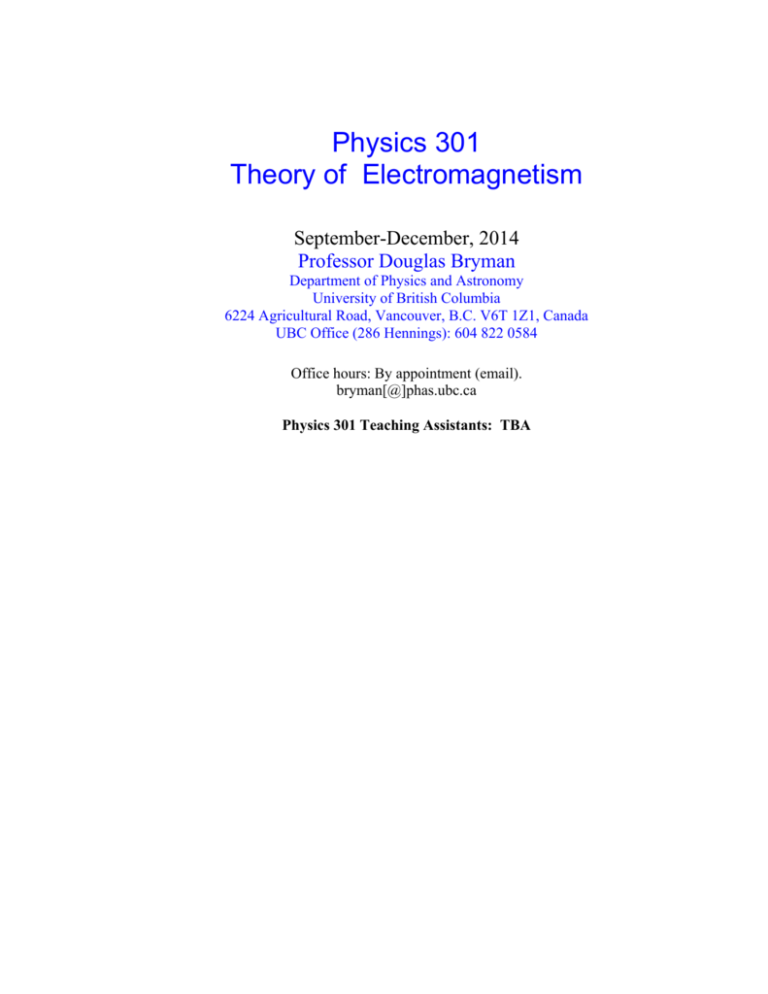
Physics 301 Theory of Electromagnetism September-December, 2014 Professor Douglas Bryman Department of Physics and Astronomy University of British Columbia 6224 Agricultural Road, Vancouver, B.C. V6T 1Z1, Canada UBC Office (286 Hennings): 604 822 0584 Office hours: By appointment (email). bryman[@]phas.ubc.ca Physics 301 Teaching Assistants: TBA Physics 301 Course Information Connect: http://elearning.ubc.ca/connect/ Course information (this file, Physics301_Course_Information 2014.pdf), calendar (301Schedule.pdf), homework assignments, and homework solutions, will be posted on the 301 Connect site. Time, Location: Lectures MWF 13:00-14:00 Hennings 201 Tutorial Tu 13:00-14:00 Hennings 202 or W 9:00-10:00 Hennings 202 Text: Introduction to Electrodynamics, D. Griffiths,4th edition (2013). Others sources (some available at the library): – Electricity and Magnetism, E. Purcell – Electromagnetic Fields and Waves, P. Lorrain, et al. – Electromagnetism, Pollack and Stump (2002) – Classical Electrodynamics, J. D. Jackson (Graduate level) Clickers: Obtain an iclicker from the bookstore (unless you already have one). Register your clicker for this course. Note: if your bar code is rubbed off, you can take it to the library (aka learning centre) to have its RFID tag read. Grades – – – – Homework Assignments (15%) In-class assignments, Pre-reading and Clicker Quizes (5%) Midterm Exam (35%) Final exam (45%) Homework Assignments: Homework problem sets are due at class time on the date indicated. Late assignments will not be accepted (except for tragic or medical reasons). Only some “randomly” selected problems may be graded but solutions to all will be posted on the web site. In-class Activities: Learning by “doing” with peer instruction is especially effective. This course will use a hybrid approach i.e. material will be presented by lecture accompanied by structured in-class group work and mini-quizes. For in-class activities, work in small groups of 3-5; ask for assistance when stuck. To maximize your learning, come prepared by doing the prereading assignment. Lecture previews will be posted indicating the text sections to read in advance along with tips and questions to think about. Pre-reading may be rewarded with clicker quizzes that can easily be answered if you read the assigned passages in the text and with the extra benefit that you’ll be prepared for the classroom learning. Lectures, In-class Activities Tentative subjects for the lectures along with the homework assignments have been posted on the Connect site (Phys301 Schedule 2014.pdf). Work sheets for in-class activities may be handed out at the beginning of the class. Some lecture notes will be posted after the class. Topics The course will cover material in Chapters 1-7 and 12 in Griffths' text. Math Tool Kit: Review of vectors, calculus Electrostatics Electric Fields and Potentials - Poisson and Laplace Equations Multipoles Energy and Capacitance Dielectrics Boundary Value Problems Relativity and Magnetic Fields (Ch. 12) Magnetostatics Magnetic Fields and Vector Potential Magnetic Materials Magnetic Forces and Energy, Inductance Faraday Induction Maxwell's Equations Tutorials In addition to occasional quizzes, tutorials will be opportunities for discussion and review of problems and applications of E&M. Make-up lectures may also be given in the tutorials. Academic Integrity! Friendly Advice E&M is sometimes thought to be a difficult physics course but it is one of the most important. Everything in E&M follows from a few basic principles which are then elaborated using the math techniques reviewed in the first chapter of the text. A thorough understanding of these techniques is key to success in E&M. To benefit most from the lectures and tutorials, read the appropriate text sections in advance and come to class with questions. To learn this subject well, it takes practice. So, do as many problems as possible, in addition to the homework assignments! (It’s recommended by experts in teaching E&M that students do at least one problem each day. The Griffiths text is an excellent source of problems.) 301 Course Objectives and Comments See PHYS 301 Learning Goals.pdf on the Connect site. Course-Level Goals Electricity and Magnetism is one of the most important courses you’ll take because it is relevant to virtually all fields of science. That is one reason there are E&M courses at all levels from high school to graduate school. 1. The derivations in this course are sometimes lengthy but the mathematics used in these derivations is not advanced. Before the course is over, you’ll be so good at the mathematical manipulations that the math won’t get in the way of seeing the underlying physics. 2. While you are expected to remember basic relationships from physics like F=dp/dt and c you do not have to memorize complicated formulas we derive in class. A list of formulas will be given for exams. You will be able to select the applicable formula from the list and know how to apply it to the task you’re working on. 3. You are not expected to memorize lengthy derivations. Rather, through recognition and familiarity with the basic principles and with the help of the text, a formula list, and other resources, you’ll be able to go back and re-derive relationships and properties as needed. 4. It will be your habit to assess new results from the points-of-view of math (e.g. does the formula make sense? what happens in the limit as...?) and physics (e.g. is this consistent with previous results? does it reproduce results seen in previous courses such as when v<<c, when reduced to 1-dimension, etc.). 5. You will be able to demonstrate how Special Relativity unifies static electric and magnetic fields by reproducing key steps in the derivation, interpretations of the mathematical relationships and analyses of real-world examples like a moving point charge, a wire carrying current, and a parallel plate capacitor. What’s the big goal for studying E&M? When you’re walking down the street, you’ll be able to visualize the surrounding “ocean” of electromagnetic waves as they travel through the air, reflect off surfaces and metal objects, refract through glass, heat up objects that absorb them, connect your phone to cell towers, turn the sky blue and the sunset red,....



